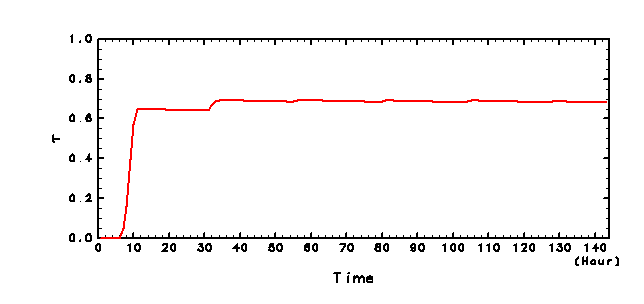|
In the dust-free case, surface stress associated with kilometer-size
convection reaches a fairly large value in the afternoon when
convective activity often peaks (Figure
5). Surface stress in the afternoon certainly exceeds the
threshold value required to raise dust from the surface when
considering a superposition of a large-scale background wind on the
convective wind (Figure 6). In
order to inject dust into the atmosphere in our convection model, a
large-scale background wind must be incorporated into the model.
However, because
- it is expected that the circulation structure of kilometer-size
thermal convection will be affected not only by dust but by the
background wind,
- it is not desirable to have an effect of large-scale background
wind on the structure of kilometer-size convection, since we are
focusing on the effect of dust on the structure of kilometer-size
convection,
in the following, we do not adjust the model parameters to incorporate
a large-scale background wind to achieve spontaneous dust injection,
but an artificial setup is adopted where the threshold surface stress
is adjusted so that dust injection occurs due to the wind associated
with kilometer-size convection in the afternoon.
The adjusted value of the threshold surface stress is 0.01 Pa. This
value is adopted based on the results of the dust-free case, in which
the maximum value of surface stress exceeded 0.01 Pa in the afternoon
(Figure 5), and when surface stress
frequently exceeded 0.01 Pa at several grid points
(Figure 6). The initial condition
is the result of the dust-free case at 6:00 LT on day 6. Numerical
integration is performed for 6 days.
Figure 9 shows the development of horizontal
mean dust opacity for solar radiation (λ = 0.67 μm). Dust
opacity rapidly increases during the first day, and afterwards, it
stays at a nearly constant value (about 0.7). In the following, we
discuss the features of dust mixing from day 1 to day 2, and the
results for day 6, when the model reaches an almost equilibrium state.
- Features of Dust Mixing
- Diurnal fluctuations in horizontal mean field
- Circulation structure of the convection

|
|
Figure 9: Time series of horizontal mean dust opacity for solar
radiation. Horizontal axis denotes numerical integration time from initial state.
|
|